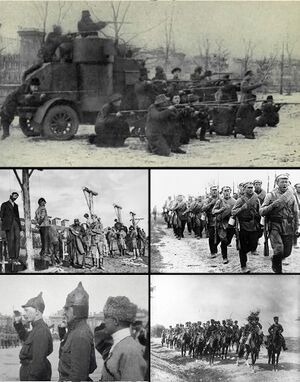Dulebian Civil War: Difference between revisions
The ©rusader (talk | contribs) mNo edit summary |
The ©rusader (talk | contribs) mNo edit summary |
||
| Line 4: | Line 4: | ||
| image = [[Image:DulCivilWarCollage.jpg|300px]] | | image = [[Image:DulCivilWarCollage.jpg|300px]] | ||
| caption = '''Clockwise from top:'''<br />Red Army soldiers and an armoured car attack Royalist positions in Ulich, 1914; a White {{wp|infantry}} division in 1915; Red cossacks of the Preobrazhenskiy Regiment; Viktor Schyukin (left) Gen. Lavrentiy Konev (centre) and Ataman Taras Konoplya in 1916; hanging of workers in Aleksandrovsk ([[Vishnevsk]]) by the [[Tudonia|Tudonian]] army, April 1917. | | caption = '''Clockwise from top:'''<br />Red Army soldiers and an armoured car attack Royalist positions in Ulich, 1914; a White {{wp|infantry}} division in 1915; Red cossacks of the Preobrazhenskiy Regiment; Viktor Schyukin (left) Gen. Lavrentiy Konev (centre) and Ataman Taras Konoplya in 1916; hanging of workers in Aleksandrovsk ([[Vishnevsk]]) by the [[Tudonia|Tudonian]] army, April 1917. | ||
| date = 15 | | date = 15 February 1914 – 5 November 1918 | ||
| place = Former [[Dulebian Empire]], Lesinia | | place = Former [[Dulebian Empire]], Lesinia | ||
| result = Victory for the Red Army in [[Dulebia]]<br />Victory for [[Tudonia]] in Dulebian Lesinia | | result = Victory for the Red Army in [[Dulebia]]<br />Victory for [[Tudonia]] in Dulebian Lesinia | ||
| Line 38: | Line 38: | ||
| strength1 = Red Army: 2,992,678 (peak) | | strength1 = Red Army: 2,992,678 (peak) | ||
---- | ---- | ||
Black Army: | Black Army: 159,900 (peak) | ||
| strength2 = White Army: 1,652,891 | | strength2 = White Army: 1,652,891 | ||
| casualties1 = TBA | | casualties1 = TBA | ||
| Line 45: | Line 45: | ||
| campaignbox = | | campaignbox = | ||
}} | }} | ||
The '''Dulebiam Civil War''' (Гражда́нская война́ в Дулебии, Grazhdanskaya voyna v Dulebii; 15 February 1914 – 5 November 1918) was a multi-party {{wp|civil war}} in the former [[Dulebian Empire]] immediately after the two [[Great Dulbian January Revolution]], as many factions vied to determine Dulebia's political future. The two major combatant groups were the [[Dulebian Red Army]], fighting for [[socialism]] led by Viktor Schyukin, and the allied forces known as the [[Dulebian White movement|White Army]], which included diverse interests favouring political {{wp|monarchism}}, {{wp|anarchism}} and alternative forms of {{wp|socialism}}. | |||
==Background== | ==Background== | ||
Revision as of 00:28, 26 September 2019
| Dulebian Civil War | |||||||||
|---|---|---|---|---|---|---|---|---|---|
| Part of the aftermath of the Continental war and the Dulebian Revolution | |||||||||
 Clockwise from top: Red Army soldiers and an armoured car attack Royalist positions in Ulich, 1914; a White infantry division in 1915; Red cossacks of the Preobrazhenskiy Regiment; Viktor Schyukin (left) Gen. Lavrentiy Konev (centre) and Ataman Taras Konoplya in 1916; hanging of workers in Aleksandrovsk (Vishnevsk) by the Tudonian army, April 1917. | |||||||||
| |||||||||
| Belligerents | |||||||||
|
(1914-15) |
Including
Other new republics Tudonian-led intervention (1917-1918) Including
| ||||||||
| Commanders and leaders | |||||||||
|
|
| ||||||||
| Strength | |||||||||
|
Red Army: 2,992,678 (peak) Black Army: 159,900 (peak) | White Army: 1,652,891 | ||||||||
| Casualties and losses | |||||||||
| TBA | TBA | ||||||||
| TBA | |||||||||
The Dulebiam Civil War (Гражда́нская война́ в Дулебии, Grazhdanskaya voyna v Dulebii; 15 February 1914 – 5 November 1918) was a multi-party civil war in the former Dulebian Empire immediately after the two Great Dulbian January Revolution, as many factions vied to determine Dulebia's political future. The two major combatant groups were the Dulebian Red Army, fighting for socialism led by Viktor Schyukin, and the allied forces known as the White Army, which included diverse interests favouring political monarchism, anarchism and alternative forms of socialism.